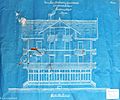Blueprint facts for kids
A blueprint is a special kind of copy of a technical drawing. It shows designs for things like buildings or machines. Blueprints are made using a special printing method on paper that reacts to light.
This method was invented in the 1800s. It made it fast and easy to copy important documents used in building and industry. Old blueprints usually had light-colored lines on a blue background. They were like a photo negative of the original drawing. They could not show colors or different shades of gray.
Blueprints were made on different materials. Paper was common. For copies that needed to last longer, people sometimes used linen fabric. But linen could shrink a little over time. Later, people started using imitation vellum or plastic film like Mylar to avoid this problem.
Today, blueprints are mostly replaced by newer printing methods. These include whiteprints and large photocopiers. So, these copied drawings are now usually just called "prints" or "drawings."
The word blueprint is also used in a more general way. It can mean any floor plan or even just any kind of plan for something.
Contents
How Blueprints Were Made
In 1861, a French chemist named Alphonse Louis Poitevin discovered something interesting. He found that a chemical called ferro-gallate, when mixed with gum, was sensitive to light. When light hit it, it turned into a strong, permanent blue color that wouldn't wash away.
This discovery led to the blueprint process. Paper was coated with this yellow chemical mixture and then dried. This coated paper could stay good in the dark for up to three days.
To make a blueprint, the coated paper was placed under a clear glass sheet. On top of the paper, the original drawing was laid. This drawing had to be on a see-through material. This whole setup was put in a special frame, like a picture frame. Then, it was placed outside in daylight.
It took only a minute or two in bright sunshine to make a copy. On a cloudy day, it might take about ten times longer. Wherever ultraviolet light passed through the clear parts of the original drawing, the yellow coating changed. It turned into a strong blue or black color. As the image appeared, the frame was brought inside. The yellow coating that was under the lines of the original drawing (where light didn't reach) was then washed away. After that, the paper was dried.
The final blueprint was a copy of the original drawing. The background was dark blue, and the lines of the drawing appeared in white. This image was very stable.
This contact printing method had some good points. It didn't need a big, complex optical system. Also, the copied drawing would be the exact same size as the original. Another useful thing was that the dark blue background made it hard to add new information to the print later. This meant a blueprint couldn't be easily changed. Depending on the situation, this could be a good or bad thing.
Because the paper got wet during the process, its size could change slightly. The paper could also become brittle. Engineers often wrote notes on their drawings to remind people not to trust the scale of the copies too much.
Other blueprint methods also used light-sensitive iron compounds. One well-known method used ammonium ferric citrate and potassium ferricyanide. This process created a very distinct blue color and is also called cyanotype. Paper was soaked in a solution of ammonium ferric citrate and dried. When light hit the paper, the iron in the chemical changed. Then, the image was developed using a solution of potassium ferricyanide. This created an insoluble blue compound called Turnbell's blue (which is the same as Prussian blue). Any extra chemicals were then washed away.
This was a simple way to copy any drawing that let light pass through. Engineers and architects would draw their designs on special paper. Then, they would trace these designs onto tracing paper using India ink. This made them ready to be copied whenever needed.
The invention of the blueprint process saved a lot of money. Before blueprints, copying drawings was expensive. By the late 1890s in American architectural offices, a blueprint cost only one-tenth of what a hand-traced copy did. Today, the blueprint process is still used for special art and photography effects on paper and fabrics.
Blueprints Replaced by Whiteprints
Traditional blueprints have mostly been replaced by newer, cheaper ways to print and by digital screens. In the early 1940s, the blue-on-white blueprint started to be replaced by diazo prints. These are also known as whiteprints. They have blue lines on a white background. Because of this, these drawings are sometimes called blue-lines. Other similar prints that use dyes are called blacklines.
Related pages
Images for kids
See also
 In Spanish: Blueprint (dibujo técnico) para niños
In Spanish: Blueprint (dibujo técnico) para niños





